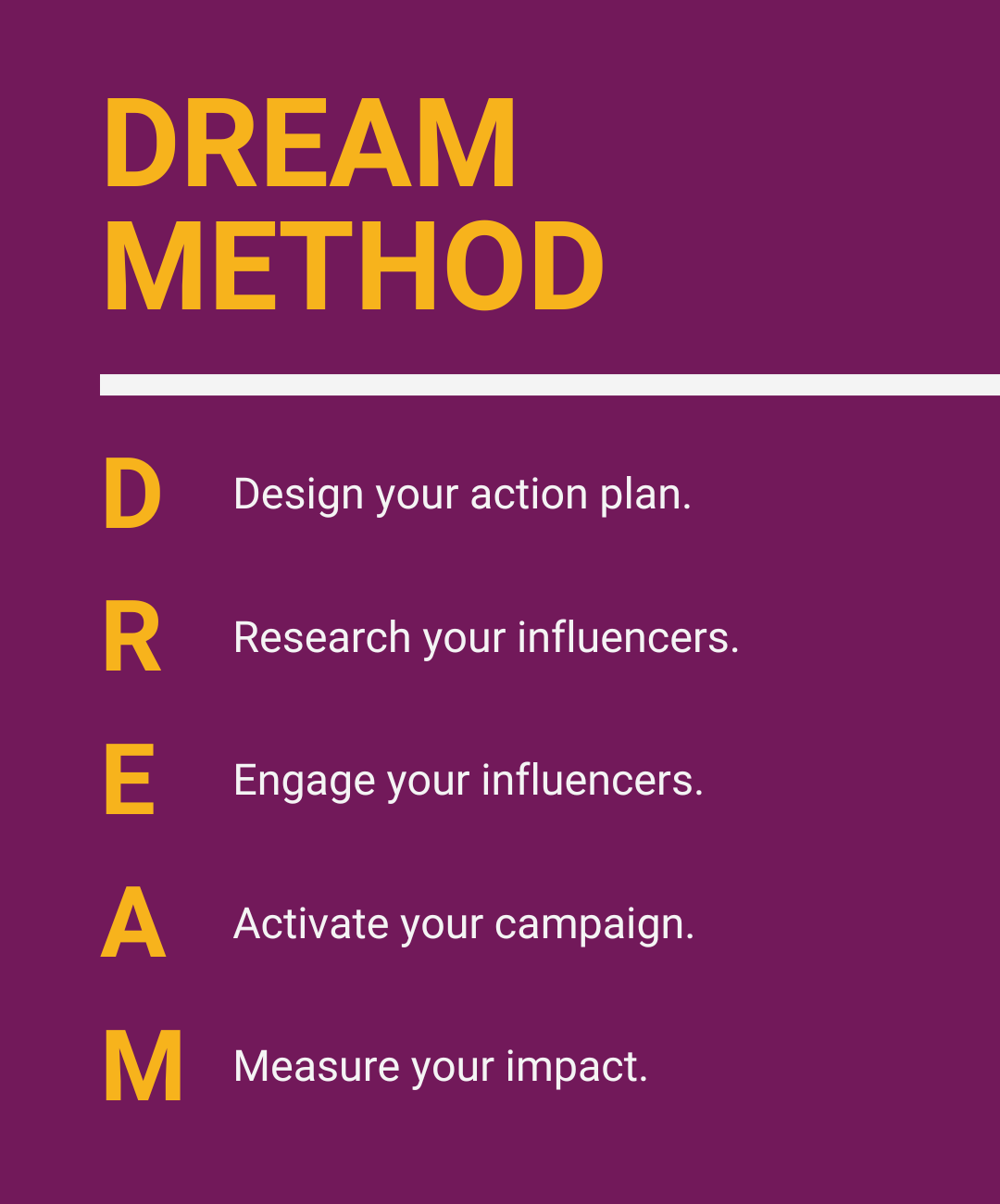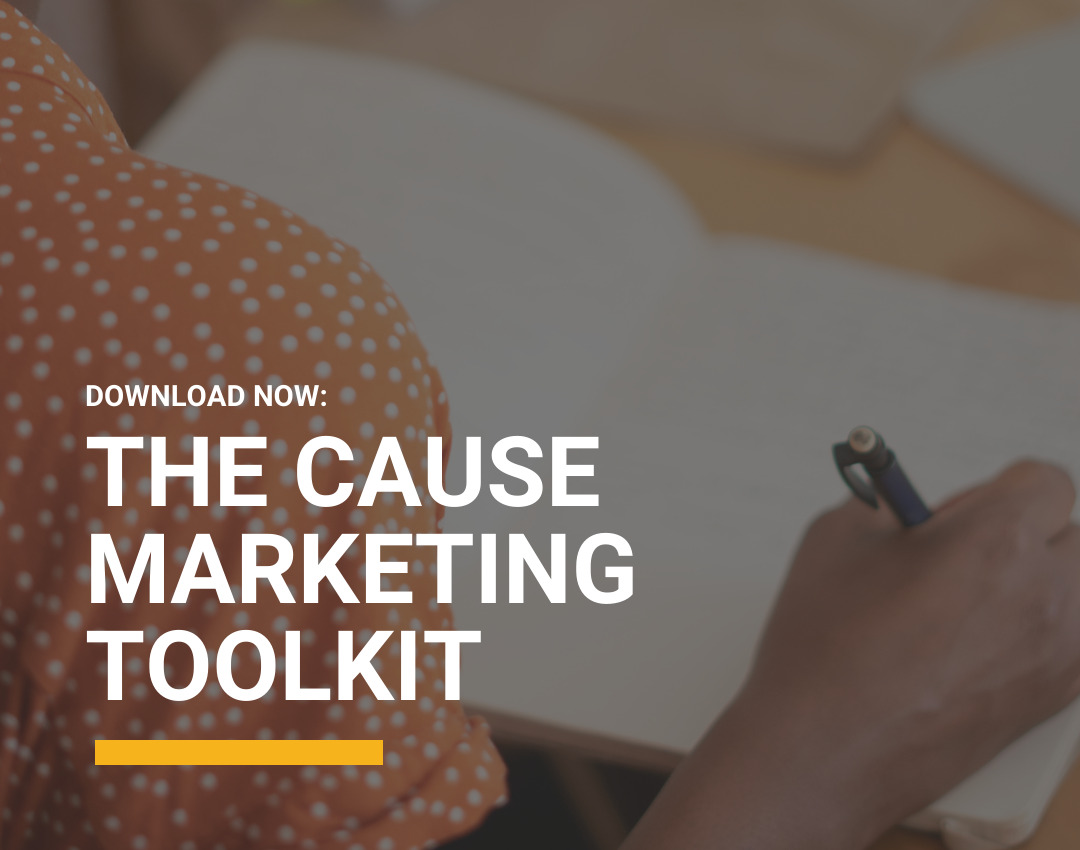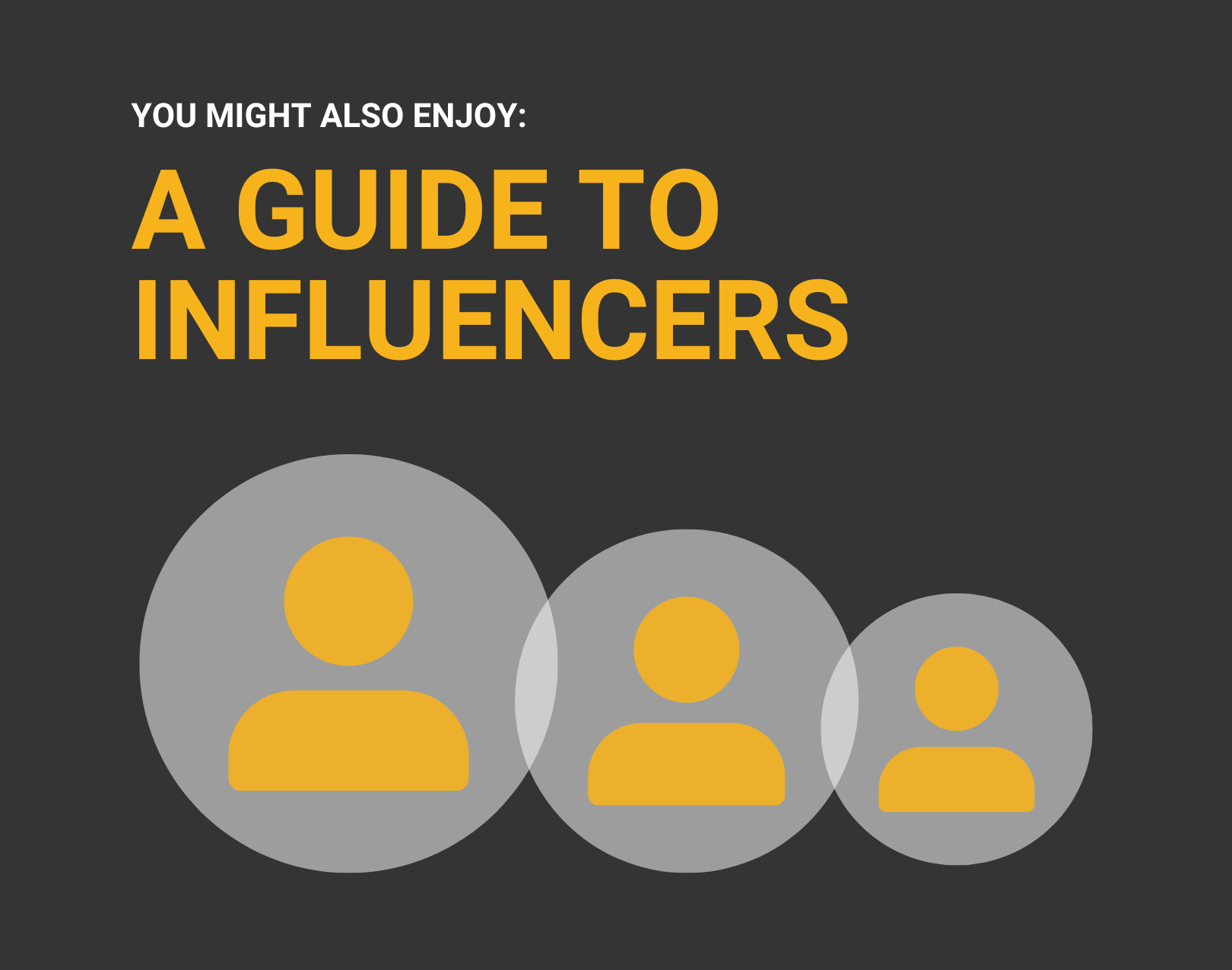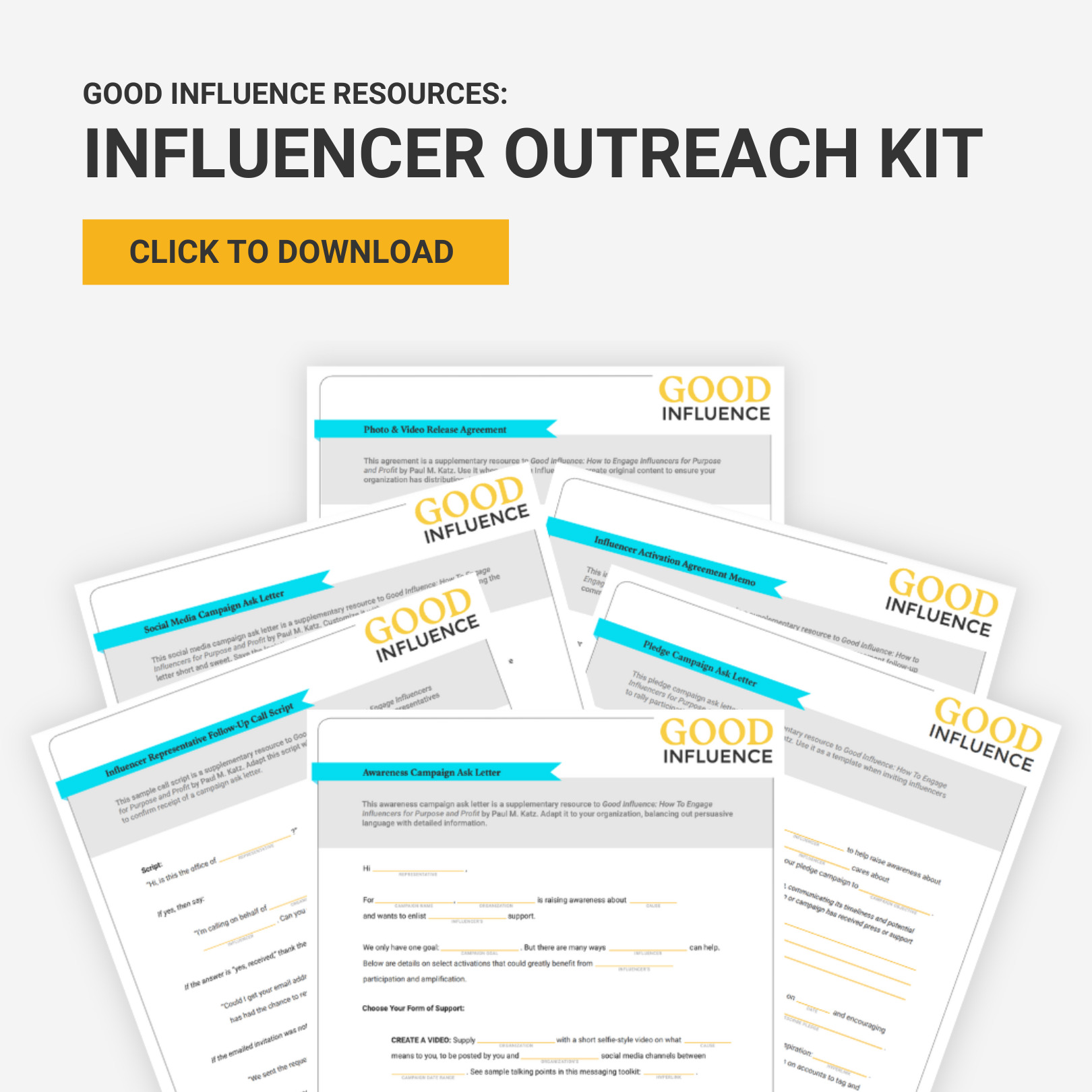Influencer marketing has transformed marketing in the last 15 years with one unfortunate exception: the philanthropic world. For many nonprofits, influencer marketing sounds exciting but feels uncertain. Either they don’t know where to start, feel ill-equipped to manage talent relationships, or lack the confidence to adopt a new strategy—all valid. But having worked on more than 100 influencer-led social impact campaigns, I know that nonprofits are missing out by not tapping into the proven power of celebrity and influencer marketing.
That’s why I wrote Good Influence: How to Engage Influencers for Purpose and Profit. Using my D.R.E.A.M. method, I wanted to demystify the entertainment world and break down the process of creating influencer-led social impact campaigns so that any purpose-driven leader can create their own nonprofit influencer marketing campaign. Entertain Impact clients, from the WHO Foundation to New Georgia Project, are familiar with D.R.E.A.M. For people who haven’t worked with Entertain Impact or read Good Influence, here’s a brief overview.

The five steps of Paul M. Katz’s D.R.E.A.M. Method.
Step 1: Design Your Action Plan
The first step of D.R.E.A.M. speaks to the importance of having a plan that outlines the parameters of your nonprofit marketing campaign and details the steps to bring it to life.
Every campaign is different, and so is every action plan. But there are key elements that must be included because they directly inform the campaign:

- Organizational goals
- Marketing objectives
- Campaign objectives
- Target audiences (primary and secondary)
- Key messages
- Desired action(s)
- Driving moments (events, milestones, launches, etc.)
- Activation calendar
- Influencer integration opportunities
- Priority channels (social platform, email, website)
- Measurement systems
Doing this deep-dive at the outset can help you figure out your budget, assemble teams, and develop a timeline. It can also uncover different ways for public figures to get involved. For example, you could collaborate with an artist to create art for your social impact campaign, ask them to amplify your work at an event, or keep things digital by sharing your mission on social. Explore all possibilities as you develop your campaign and design an action plan.
Step 2: Research Your Influencers
Once you have a plan for integrating influencers, it’s research time. Thoughtful research allows you to find and vet influencers who match your values and reach your target audience.
When researching public figures for your nonprofit campaign, remember the four influencer categories:
- Mega-influencers: > 1 million followers
- Macro-influencers: 100,000 – 1 million followers
- Micro-influencers: 10,000 – 100,000 followers
- Nano-influencers: < 10,000 followers
Mega-and macro-influencers (often major celebrities) are great for amplifying a campaign, lending credibility and reaching new audiences. Micro-and nano-influencers, on the other hand, are often more persuasive and able to generate action.
Follower count isn’t the only thing nonprofit marketers need to consider when conducting influencer research. Mission connection, reputation, and potential conflicts of interest are also important. You must ask:
- Has the influencer publicly spoken in favor of your issue?
- Do they have a personal connection to your cause?
- Are they currently working on projects that may conflict with your campaign?
- Are they presently supporting other organizations in your space?
Step 3: Engage Your Influencers
The third step of D.R.E.A.M. covers the ins and outs of engaging influencers and celebrities. Public figures are bombarded with requests to support social impact campaigns, so make an ask that inspires and instills confidence.
When inviting influencers to support your nonprofit social impact campaign, include the following:
- Introduce the issue and explain the campaign’s “why”
- Specify the connection between the influencer and your mission
- Lay out the potential impact of their support
- Describe the influencer onboarding process and planned activations
- List other public figures supporting the campaign
For a complete Influencer Outreach Kit, including multiple ask letter templates, a call script, an outreach tracking grid, and more, click here.
Step 4: Activate Your Campaign
This step has the greatest variability. In Good Influence, I devote 40+ pages to covering different activations and share multiple case studies to drive home best practices and watch-outs for purpose-driven organizations, whether their influencer activation is a social post or full-fledged ambassadorship. I also recommend simple, often missed, steps to make the most of the connections made as a result of the campaign. For example:
- Go beyond thank you and start your relationship by sharing about your organization’s work
- Send an agreement letter, like the one in this Influencer Outreach Kit, to ensure alignment on terms and next steps
- Schedule check-in calls with representatives close to campaign activations
- If activations are on social media, make sure your team engages with supporters’ posts
- Send public figures wrap reports summarizing the impact of their participation
- Touch base during birthdays, holidays, and milestones to say hi and share updates
Activating influencers on behalf of a campaign should be more than a transaction. Tending to the relationships you create can lead to repeat support. It’s also just a kind thing to do!
Step 5: Measure Your Impact
The final step of D.R.E.A.M. details how to measure your nonprofit campaign and apply learnings to future programs.
Many nonprofits measure in terms of fundraising. While revenue is important to track, there are other marketing metrics to clue you in on whether a campaign was successful and, more importantly, why. If your campaign is primarily digital, pay attention to changes in your social media engagement, visits to your landing page, and newsletter growth. Even for pure fundraising campaigns, you might miss the whole picture if you only look at total dollars raised versus dollars by segment, first-time donors, donor retention, and other tangential metrics.
Here are five steps to set up the right measurement strategy for your nonprofit’s social impact campaign:
- Determine your goals: Decide what you want to achieve from the campaign (e.g., increase donations, raise awareness, or engage membership).
- Choose communications tactics: Decide the steps you’ll take to reach your goals (e.g., host an event, run a PR campaign, content creation, etc.).
- Identify metrics: Connect the dots between your campaign goals and the communications tactics to determine which metrics best measure success.
- Define your metrics: Work with your team to determine what success in your campaign looks like in real terms. Consider creating a “Quality Index Score” to make sure things are evaluated objectively.
- Analyze the data: Regularly track campaign metrics and analyze data to see which tactics are working and which you need to refine.
Any Nonprofit can Create Successful Influencer-led Campaigns with the D.R.E.A.M. Method
D.R.E.A.M. is an effective method for nonprofit marketers to create successful influencer-led social impact campaigns. By breaking down the process into five manageable steps (Design, Research, Engage, Activate, and Measure), purpose-driven leaders can create campaigns that raise awareness, reach new audiences, and drive real change.
If you already have a copy of Good Influence, save this blog as a reference guide. For those of you who haven’t yet read the book, I hope you found this overview helpful, and I invite you to peek inside the book’s first chapter here.
This article was written by Paul Katz.









